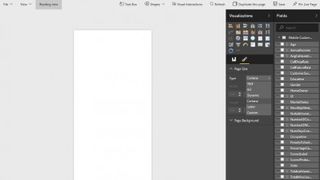Embedded Power BI Microsoft cloud apps could all turn into platforms
Software developers want to integrate Power BI into their own products
Milliman is one of the biggest actuarial consulting firms in the world, but it has fewer than ten people in its tech support team because the firm has built its ETL, analytics and reporting service using Azure PaaS services.
"We don't want the overhead of infrastructure," insisted Maher, "the operational cost of that is immense. We want a cloud pricing model. We're a modern data warehouse that's a hyperscale service in the cloud – we provide big compute to actuaries who upload models into our platform and run on tens of thousands of cores.
"We pull assets from various accounting systems, data of all shapes and sizes into the cloud. When the data is on-premise, it's locked into compartments. Moving it to the cloud gives them a lot more accessibility."
Milliman wanted to add visualisation features but didn't want to build them from scratch. "There are complex things happening with the financial modelling and with Power BI, the actuary can visualise the data and that integration really lights it up for them. If we had had to build this, it would have been a horrendous amount of work," Maher says. "There are things we wouldn't even have thought of in Power BI and we're able to embrace them and pass that on to our clients, so we can push forward at a great rate."

Huge scale
Milliman is expecting to need the scale of Azure for customers – some companies need to provide quarterly reports to regulators and that can mean building a dashboard view that requires running 10,000 calculations. "You have to bring all your data together for these regulatory reports," explained Tom Peplow from Milliman. "For some businesses we're working with, it's the first time they've had a single view of all their data. They've got 20 mainframes and now we've got one data set that describes their entire business."
Acumatica is also embedding Power BI. Phillips describes them as a "midmarket ERP SaaS service that competes with NetSuite. They were constantly being beat up by NetSuite because they didn't have good reporting and analytics technology. By integrating with Power BI they leapfrogged NetSuite – now they've got far richer reporting, including natural language reporting, and they didn't have to dedicate any of their engineers to building it. They didn't have to become an analytics software company to get this."
Phillips says "dozens and dozens" of companies are going to embed Power BI in their own tools – it could start showing up in services you use pretty quickly. Maher says it only took the Milliman team two weeks to integrate it.
Are you a pro? Subscribe to our newsletter
Sign up to the TechRadar Pro newsletter to get all the top news, opinion, features and guidance your business needs to succeed!
Business are already using the many software packages built on top of the Reporting Services in SQL Server but Power BI Embedded reinvents that for the cloud world, Phillips told techradar pro. "A modern app platform for business has to bring three things together. There's analytics, Power BI, showing you the needle of what's happening in your business, and then there's modern applications that allow you, procedurally or declaratively, to move the needle.
"The next step is some orchestration that allows you to start the process of automating the movement of that needle, including analytical systems that make recommendations humans can take into account when they make decisions. When you bring those things together, you've got a powerful platform and Power BI is one of the ingredients."
Part app, part platform
Being able to use Power BI inside third-party apps and services makes it not just a cloud service, but a platform. Office 365 and Dynamics already offer similar options – DocuSign uses Office 365 services to look up email addresses for users from their Outlook contacts list and even checks for out of office messages before you send a document for signing, in case it's an urgent document.
It's the kind of thing we should expect to see for all of Microsoft's cloud services, Phillips said. "I'd argue that if you look at all our SaaS services and our finished applications, we will always seek to provide the application which is the finished product and grows the market, and then also offer it as a service to build on. This is core to how we think about our services: part app, part platform."
Contributor
Mary (Twitter, Google+, website) started her career at Future Publishing, saw the AOL meltdown first hand the first time around when she ran the AOL UK computing channel, and she's been a freelance tech writer for over a decade. She's used every version of Windows and Office released, and every smartphone too, but she's still looking for the perfect tablet. Yes, she really does have USB earrings.
